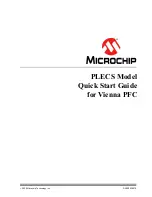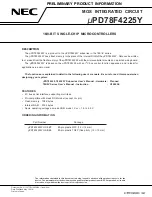
C-8
G60 Generator Protection System
GE Multilin
C.4 GENERIC SUBSTATION EVENT SERVICES: GSSE AND GOOSE
APPENDIX C
C
C.4GENERIC SUBSTATION EVENT SERVICES: GSSE AND GOOSE
C.4.1 OVERVIEW
IEC 61850 specifies two types of peer-to-peer data transfer services: Generic Substation State Events (GSSE) and Generic
Object Oriented Substation Events (GOOSE). GSSE services are compatible with UCA 2.0 GOOSE. IEC 61850 GOOSE
services provide virtual LAN (VLAN) support, Ethernet priority tagging, and Ethertype Application ID configuration. The sup-
port for VLANs and priority tagging allows for the optimization of Ethernet network traffic. GOOSE messages can be given
a higher priority than standard Ethernet traffic, and they can be separated onto specific VLANs. Because of the additional
features of GOOSE services versus GSSE services, it is recommended that GOOSE be used wherever backwards com-
patibility with GSSE (or UCA 2.0 GOOSE) is not required.
Devices that transmit GSSE and/or GOOSE messages also function as servers. Each GSSE publisher contains a “GSSE
control block” to configure and control the transmission. Each GOOSE publisher contains a “GOOSE control block” to con-
figure and control the transmission. The transmission is also controlled via device settings. These settings can be seen in
the ICD and/or SCD files, or in the device configuration software or files.
IEC 61850 recommends a default priority value of 4 for GOOSE. Ethernet traffic that does not contain a priority tag has a
default priority of 1. More details are specified in IEC 61850 part 8-1.
IEC 61850 recommends that the Ethertype Application ID number be configured according to the GOOSE source. In the
G60, the transmitted GOOSE Application ID number must match the configured receive Application ID number in the
receiver. A common number may be used for all GOOSE transmitters in a system. More details are specified in IEC 61850
part 8-1.
C.4.2 GSSE CONFIGURATION
IEC 61850 Generic Substation Status Event (GSSE) communication is compatible with UCA GOOSE communication.
GSSE messages contain a number of double point status data items. These items are transmitted in two pre-defined data
structures named DNA and UserSt. Each DNA and UserSt item is referred to as a ‘bit pair’. GSSE messages are transmit-
ted in response to state changes in any of the data points contained in the message. GSSE messages always contain the
same number of DNA and UserSt bit pairs. Depending the on the configuration, only some of these bit pairs may have val-
ues that are of interest to receiving devices.
The
GSSE FUNCTION
,
GSSE ID
, and
GSSE DESTINATION MAC ADDRESS
settings are used to configure GSSE transmission.
GSSE FUNCTION
is set to “Enabled” to enable the transmission. If a valid multicast Ethernet MAC address is entered for the
GSSE DESTINATION MAC ADDRESS
setting, this address will be used as the destination MAC address for GSSE messages. If
a valid multicast Ethernet MAC address is not entered (for example, 00 00 00 00 00 00), the G60 will use the source Ether-
net MAC address as the destination, with the multicast bit set.
C.4.3 FIXED GOOSE
The G60 supports two types of IEC 61850 Generic Object Oriented Substation Event (GOOSE) communication: fixed
GOOSE and configurable GOOSE. All GOOSE messages contain IEC 61850 data collected into a
dataset
. It is this dataset
that is transferred using GOOSE message services. The dataset transferred using the G60 fixed GOOSE is the same data
that is transferred using the GSSE feature; that is, the DNA and UserSt bit pairs. The FlexLogic operands that determine
the state of the DNA and UserSt bit pairs are configurable via settings, but the fixed GOOSE dataset always contains the
same DNA/UserSt data structure. Upgrading from GSSE to GOOSE services is simply a matter of enabling fixed GOOSE
and disabling GSSE. The remote inputs and outputs are configured in the same manner for both GSSE and fixed GOOSE.
It is recommended that the fixed GOOSE be used for implementations that require GOOSE data transfer between UR-
series IEDs. Configurable GOOSE may be used for implementations that require GOOSE data transfer between UR-series
IEDs and devices from other manufacturers.
C.4.4 CONFIGURABLE GOOSE
The configurable GOOSE feature allows for the configuration of the datasets to be transmitted or received from the G60.
The G60 supports the configuration of eight (8) transmission and reception datasets, allowing for the optimization of data
transfer between devices.
Содержание Multilin g60
Страница 10: ...x G60 Generator Protection System GE Multilin TABLE OF CONTENTS INDEX ...
Страница 32: ...1 22 G60 Generator Protection System GE Multilin 1 5 USING THE RELAY 1 GETTING STARTED 1 ...
Страница 130: ...3 68 G60 Generator Protection System GE Multilin 3 4 FIELD AND STATOR GROUND MODULES 3 HARDWARE 3 ...
Страница 160: ...4 30 G60 Generator Protection System GE Multilin 4 3 FACEPLATE INTERFACE 4 HUMAN INTERFACES 4 ...
Страница 486: ...5 326 G60 Generator Protection System GE Multilin 5 10 TESTING 5 SETTINGS 5 ...
Страница 518: ...6 32 G60 Generator Protection System GE Multilin 6 5 PRODUCT INFORMATION 6 ACTUAL VALUES 6 ...
Страница 532: ...7 14 G60 Generator Protection System GE Multilin 7 2 TARGETS 7 COMMANDS AND TARGETS 7 ...
Страница 538: ...8 6 G60 Generator Protection System GE Multilin 8 1 PHASE DISTANCE THROUGH POWER TRANSFORMERS 8 THEORY OF OPERATION 8 ...
Страница 748: ...D 10 G60 Generator Protection System GE Multilin D 1 IEC 60870 5 104 APPENDIX D D ...
Страница 760: ...E 12 G60 Generator Protection System GE Multilin E 2 DNP POINT LISTS APPENDIX E E ...
















































